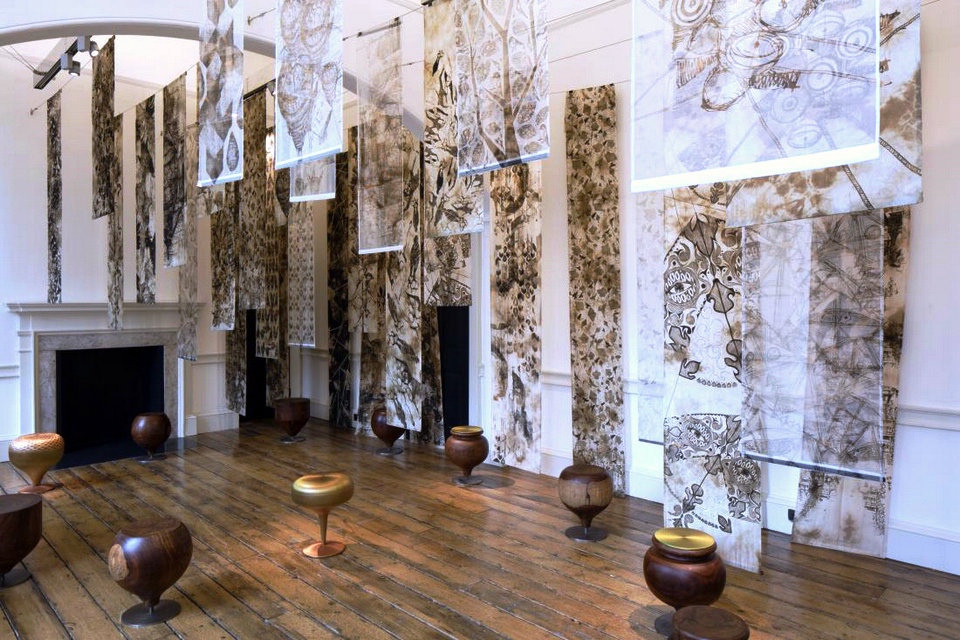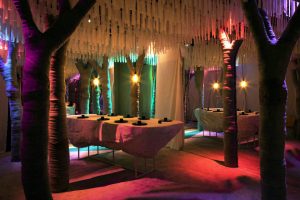London Design Biennale is a global gathering of the world’s most ambitious and imaginative designers, curators and design institutions.
Belgium: Eutopia
Belgium mused on today’s EUtopia by producing a new utopian map as a symbolic wake-up call for Europe. Thomas More’s Utopia was first published in the Belgian city of Leuven, along with a map of the fictional island in the shape of a human skull. Belgium’s design team reconsidered these utopian roots in light of the Belgium of 500 years later; Brussels is Europe’s capital but, with Brexit, the 50-year dream of a united Europe is fast unravelling. The artist van Innis, whose murals in Maalbeek subway station, just 600m from the EU parliament, were destroyed in last year’s terrorist attack, considered this uncertain future in a new map of EUtopia.
Designer: Benoît van Innis
Curators: DAMNº magazine: Siegrid Demyttenaere, Walter Bettens
Greece: Utopian Landscape
Utopian Landscape, a digital recreation of a marble quarry at Dionysus, was potent ground for an investigation into heritage, trade and population movement. For on•entropy, marble and light served as useful metaphors for the shifting social and cultural patterns caused by migration, and for the paradoxes, continuities and disruptions of utopia. Marble idols, made in the Cyclades islands 5,000 years ago, were widely distributed across the Aegean Sea, providing evidence of early trade and travels. The Greek team referenced the current flows and transitions of people, contextualised against a long history of population movement through Greece – a geographic bridge between east and west.
Design Team: Niki and Zoe Moskofoglou of on • entropy; Eleftheria Deko, Domnika Gregoriades (design); Daphne Stylianou, Zoe Moskofoglou (research); Production: Giorgos Malekakis (photography); Vassilis Sfakianopoulos (mapping director); dtmh (video); Nikos Eleftheras (music)
Curators: on • entropy
Pakistan: Daalaan
Pakistan’s installation, Daalaan, was a collaboratively designed abstract ‘playground’ that broke down social barriers and invited interaction between strangers. Taking the simplicities of our childhoods as a reference, the Pakistani team created a playroom ‘where imagination has no bounds’, to encourage people to meet through play and transported them back to a time when they were unhindered by adult anxieties. They hoped their playful installation – which featured sheesham wood objects, Lattoo Stools (spinning tops), hand-drawn artworks and screen prints made using natural henna dyes – encouraged people to converse and share ideas with open minds.
Design Team: Salman Jawed, Ali S Hussain, Faiza Adamjee, Hina Fancy, Zaid Hameed, Mustafa Mehdi
Curators: Coalesce Design Studio; Salman Jawed
Spain: Vrpolis, Diving Into The Future
With thousands of sensors that monitor things such as air pollution, noise and temperature, the smart city of Santander uses technology to improve urban life and the environment. Inspired by its success, VRPolis, Diving into the Future asks what a smart city could be capable of 100 years from now. An immersive 360-degree virtual-reality film imagines how medium-sized towns of the future could harness new technologies to make improvements in the fields of energy, mobility, connectivity, habitat, architecture, water and waste. This project shows prospective and possible sustainable futures based on emerging trends. It is a practical tool and could play an inspirational role for inventors and innovators.
Design Team: Dimeloami Productions, María Levene
Curator: Maite Cantón
Tunisia: Pulse Diagram
In Pulse Diagram, architect Chacha Atallah, working in collaboration with artist Haythem Zakaria, reflects on the fragile foundations of so-called utopias. It is composed of 54 pylons, which refer to the 54 cities in More’s Utopia, linked to each other by charred beams, created using an ancient Japanese technique that scorches the wood to extend its lifespan. In the early 1960s, the architect Yona Friedman proposed a ‘mobile city’, a series of moveable and floating megastructures, suspended on a grid of stilts so that they left a minimal footprint. With its burned wood supports, the Tunisian installation both celebrates Friedman’s ‘feasible utopia’, and points to its fragile foundations.
Design Team: Chacha Atallah, Haythem Zakaria
Curator: Bertrand Sigwalt
Uae: Al Falaj: Water Systems Of The Gulf’s Oases
A vast system of planned irrigation once stretched across the Gulf, bringing water and vitality to desert communities. Al Falaj: Water Systems of the Gulf’s Oases shows how it could again be relevant to the UAE’s rapidly globalising cities. Based on studies of the few authentic examples of falaj channels still in use, the exhibition explores how the idea could be adapted for use today. As well as an effective agricultural system, Al Falaj is a utopian idea in nature. Applied over centuries of development, the channels have become places where public and private realms meet, facilitating exchange. It is also a fair way of dividing water, a measured way of allocating resources in a hot and dry climate.
Design Team: Cultural Engineering; Case Design
Curators: Rashid Bin Shabib, Ahmed Bin Shabib, Samuel Barclay, Anne Geenen
Design Biennale 2016
The first London Design Biennale takes place at Somerset House, bringing design installations and exhibitions from 37 of the world’s nations to the heart of the capital. Designers Edward Barber & Jay Osgerby have worked alongside the V&A to create Forecast – a wind powered installation which is displayed in the Edmond J. Safra Fountain Court as the UK’s entry. Forecast responds to the inaugural Biennale’s theme ‘Utopia by Design’; a celebration of the 500th anniversary of the publication of Thomas More’s inspirational text, as part of Somerset House’s UTOPIA 2016 season.
Somerset House
Somerset House is London’s working arts centre built on historic foundations around one of the most beautiful courtyards in Europe.
Situated at the very heart of the capital, we are home to the UK’s largest and most exciting creative community and are overflowing with new ideas, young businesses and fresh perspectives.
Dedicated to backing progress, championing openness, nurturing creativity and empowering ideas, our cultural programme is ambitious in scope. We insist on relevance, but aren’t afraid of irreverence, and are as keen on entertainment as enrichment. We embrace the biggest issues of our times (recent exhibitions and installation have addressed climate change and the work of Black creative pioneers), but are equally committed to the delicate task of oxygenating new work by emerging artists.







